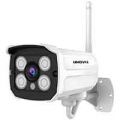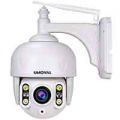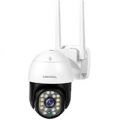Definition of SaaS
SaaS is the abbreviation of Software-as-a-Service, which means software as a service, providing software services through the network.
SaaS (Software-as-a-Service) is a completely innovative software application model that has emerged in the 21st century with the development of Internet technology and the maturity of application software. In the traditional mode, vendors use licenses to deploy software products to multiple client terminals within the enterprise for delivery. SaaS defines a new delivery method, and also makes software return to the essence of service. The essence of enterprise deployment of informatization software is for its own operation and management services. The appearance of software is the informatization of business processes, and the essence is still the first service model. SaaS has changed the way of providing traditional software services and reduced the need for local deployment. A large amount of early-stage investment, further highlighting the service attributes of informatization software, or becoming the mainstream delivery mode of the informatization software market in the future.
SaaS Platform Provider
The SaaS platform provider deploys the application software uniformly on its own server. Customers can order the required application software services from the provider through the Internet according to the actual needs of the work, and pay the manufacturer according to the number of services ordered and the length of time, and through the Internet Obtain the services provided by the SaaS platform provider.
The SaaS platform provider deploys the application software uniformly on its own server. Customers can order the required application software services from the provider through the Internet according to the actual needs of the work, and pay the provider according to the number of services ordered and the length of time, and through the Internet Obtain the services provided by the SaaS platform provider.
SaaS application software has three modes: free, paid and value-added. The payment is usually an "all-inclusive" fee, which includes the usual application software license fees, software maintenance fees, and technical support fees, which are unified into each user's monthly rental fee.
SaaS is not only suitable for small and medium-sized enterprises, enterprises of all sizes can profit from SaaS.
Features of SaaS
There are different features of SaaS as below:
(1) Internet Characteristics
On the one hand, SaaS services provide services to users in the form of Internet browsers or WebServices/Web2.0 program connections, so that SaaS applications have typical Internet technical characteristics; on the other hand, SaaS greatly shortens the gap between users and SaaS providers. The time and space distance between them makes the marketing and delivery of SaaS services very different from traditional software.
For example, the online ERP, online CRM and other modular products provided by NetSuite, a well-known product in the SaaS software industry, are all based on the network. The advantage of this is that there is no need to invest in any hardware costs, and there is no need to hire professional system maintenance personnel to access the Internet. It has a browser. You can use ERP and CRM systems. Fast implementation, convenient use, and low prices all depend on the Internet characteristics of SaaS products.
(2) Multi-tenancy Features
SaaS services are usually based on a standard software system to provide services to hundreds of different customers (also known as tenants). This requires SaaS services to support the isolation of data and configuration between different tenants, so as to ensure the security and privacy of each tenant's data, as well as the user's personalized needs such as interface, business logic, and data structure. Since SaaS supports multiple tenants at the same time, and each tenant has many users, this poses a big challenge to the performance, stability, and scalability of the infrastructure platform that supports the software. As an Internet-based software delivery model, SaaS is the core task of architects to optimize the performance and operating costs of large-scale software applications.
(3) Service Characteristics
SaaS enables software to be used by customers in the form of services based on the Internet. Therefore, many issues such as the signing of service contracts, the measurement of service use, the guarantee of online service quality, and the collection of service fees must be considered. These problems are usually not considered by traditional software.
(4) Scalable Features
Scalability means maximizing the concurrency of the system and using system resources more efficiently. For example, applications: optimize the persistence of resource locks, use stateless processes, use resource pools to share key resources such as lines and database connections, cache reference data, and partition large databases.
Application Bottleneck
(1) Technical Aspects
SaaS software personalized customization technology is not mature yet.
With the improvement of enterprise informatization, the generalized SaaS platform has been unable to meet the individual needs of enterprises, and the use of SaaS products
Multi-tenant architecture, this issue is very important. Traditional software often uses customized methods to meet individual customer needs. Of course, it can also be used for SaaS software. However, there is a big difference between SaaS software and traditional software in the customization technology: the customization of traditional software only needs to be carried out for a specific user, while the customization of SaaS requires the software to meet the respective needs of multiple tenants, requiring multiple customizations. Traditional software customization services are completed in the software development stage, while SaaS needs to update and customize in response to changes in requirements during the use of the software, and it must not affect the use of other users during customization. In addition, the SaaS customization process must be simple and easy to implement so that users can complete it by themselves. These differences make the technical design of SaaS applications more complicated, and traditional personalized customization cannot be applied in the SaaS field. Therefore, the improvement of SaaS personalized customization technology is one of the bottlenecks restricting its development.
(2) Market Aspect
The current chaotic state of the SaaS market restricts its development.
Because large customers have greater market profit opportunities, SaaS service providers focus on large customers, and small and medium customers are ignored. Companies like UFIDA and Kingdee that have transformed and developed SaaS platforms from the traditional software industry have high-quality customer resources, but are restricted by their revenue models and cannot accelerate the promotion of SaaS platforms. For small SaaS service providers, difficulties in financing and market expansion are always their problems. In addition, the driving force of the SaaS market has always been foreign experience rather than the real needs of domestic companies. Many SaaS companies have not realized the real communication with users, resulting in products that cannot meet the real needs of users. In order to compete in the market, SaaS service providers are advertising everywhere, making the immature SaaS market even more mixed.
(3) Institutional Aspects
Related laws and regulations are not perfect.
In recent years, although the government has vigorously promoted cloud computing and SaaS platforms, it is still in a stage of rapid development, and it is still a cloud that lacks legal protection. On the one hand, for users, user data under the SaaS platform is stored in the cloud, and the user does not know the processing process and storage location. The lack of legal protection of the data makes the user's trust in the service provider very low; on the other hand, the imperfect system allows criminals to take advantage of it. SaaS service providers bear the risk and responsibility of user data loss, which greatly restricts the enthusiasm of SaaS service providers to innovate and open up the market.
(4) Safety Aspect
Data security and network security are more difficult to guarantee.
Although there are currently a variety of data encryption methods, the SaaS platform requires user data security to be a dynamic security, not only to ensure that data is not lost, but also to ensure that users can change their security requirements due to business increases or decreases. Flexible adjustment. At the same time, because the platform is shared by multiple tenants, data information interaction is complicated, and the requirements for data permissions are extremely high. For network security, the stability of the Internet poses a huge challenge to the application of SaaS. The uncertainty of the corporate intranet and Internet connection is too high, and fluctuations in network stability caused by any factor will affect the use of software and even cause the loss of user data.
SaaS Advantages
(1) From a technical point of view:
SaaS is a simple deployment, no hardware is required to be purchased, and only a simple registration is required at the beginning. Enterprises no longer need to be equipped with IT professional and technical personnel, and at the same time can get the latest technology applications to meet the needs of enterprises for information management.
(2) From the perspective of investment:
The company only invests in a relatively low "monthly fee", does not require a one-time investment, does not occupy too much working capital, thereby alleviating the pressure of insufficient funds for the company; does not need to consider cost depreciation issues, and can be timely Get the latest hardware platform and the best solution.
(3) From the perspective of maintenance and management:
Because the enterprise adopts a leased method for logistics business management, it does not require specialized maintenance and management personnel, nor does it need to pay additional costs for maintenance and management personnel. To a large extent, it relieves the pressure on the human and financial resources of the enterprise, so that it can concentrate funds on the effective operation of the core business; SaaS can enable users to be a completely independent system in the world. If you are connected to the network, you can access the system.
Safety
How to distinguish whether a specific SaaS is safe or not requires the following points:
● Transmission protocol encryption.
● Server security certificate.
● URL data access security code technology.
● Data management and backup mechanism.
● Security of Operation Service System.
For an excellent software SaaS operator, the operation server and website server should be completely isolated, and even the domain name should be separated.
Development Proposals
(1) Intensify research and development efforts to solve the problem of personalized customization
In terms of personalized customization technology, currently it is mainly divided into four aspects: data customization, function customization, interface customization and business logic customization, and business logic customization is the biggest difficulty. At present, many methods for personalized customization at home and abroad have not completely solved the problem of SaaS online customization. Therefore, software providers should continue to research and develop, and seek the most appropriate personalized customization method.
(2) Multi-party assistance to jointly regulate the order of competition in the SaaS market
First, each SaaS service provider should clarify their target customers, go deep into the market, and customize their own promotional points according to user needs; second, the government needs to actively promote SaaS innovation while strengthening supervision, standardizing market competition order, and ensuring small and medium-sized enterprises. The interests of the business.
(3) The government performs its functions and improves relevant laws and regulations
The government should guide legislative work to create a secure network environment for SaaS services, such as formulating rules and regulations related to cloud computing on information security, data protection, etc., to ensure the legitimacy and standardization of SaaS services.
(4) Strengthen data and network security
The service provider should take corresponding measures at the physical layer, network layer, and system layer to improve data and network security; users can choose a large and reliable SaaS platform to understand the service provider's data backup mechanism and how to restore data, etc. Protect the security of your own financial data.




















